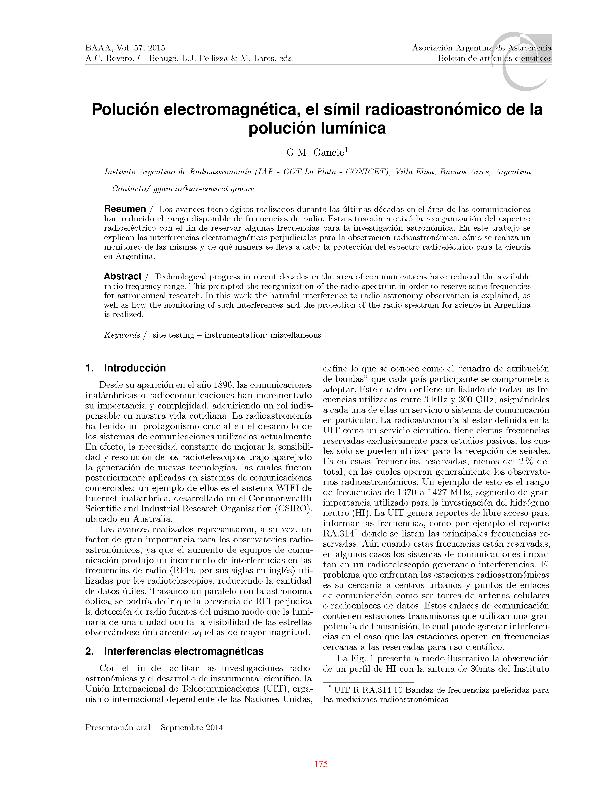Mostrar el registro sencillo del ítem
dc.contributor.author
Gancio Gonzalez, Guillermo Matias

dc.contributor.other
Rovero, Adrian Carlos

dc.date.available
2021-08-27T16:08:06Z
dc.date.issued
2015
dc.identifier.citation
Polución electromagnética, el símil radioastronómico o de la polución lumínica; Reunión Anual de la Asociación Argentina de Astronomía; Cordoba; Argentina; 2014; 175-177
dc.identifier.issn
0571-3285
dc.identifier.uri
http://hdl.handle.net/11336/139103
dc.description.abstract
Consecuencia de los avances tecnológicos en el área de las comunicaciones de las últimas décadas, la radioastronomía se ha visto limitada en su capacidad de observación del mismo modo que un telescopio óptico se ve limitado por la polución lumínica de su entorno. Esto ha traído la necesidad de organizar y administrar el espectro radioeléctrico con el fin de compartir y reservar espacios para la investigación astronómica.En el presente trabajo se buscará presentar el por que y el cuando las interferencias electromagnéticas son perjudiciales para la radioastronomía, la manera más eficiente de realizar un monitoreo de las mismas y con que herramientas administrativas se dispone para la protección del espectro radioeléctrico para la ciencia. En síntesis se intentará explicar los desafíos que deberán enfrentar la nueva generación de radio telescopios.
dc.description.abstract
As a consequence of technological advances in the area of communications in recent decades, radio astronomy has been limited in its observation capacity in the same way that an optical telescope is limited by light pollution from its environment. This has brought about the need to organize and manage the radioelectric spectrum in order to share and reserve spaces for astronomical research.In this work we will seek to present the why and when electromagnetic interference is harmful to radio astronomy, the most efficient monitoring of them and with what administrative tools are available for the protection of the radioelectric spectrum for science. In summary, an attempt will be made to explain the challenges that the new generation of radio telescopes will have to face.
dc.format
application/pdf
dc.language.iso
spa
dc.publisher
Asociación Argentina de Astronomía
dc.rights
info:eu-repo/semantics/openAccess
dc.rights.uri
https://creativecommons.org/licenses/by-nc-sa/2.5/ar/
dc.subject
Búsqueda
dc.subject
Sitio
dc.subject
Interferencia
dc.subject
Radioastronomía
dc.subject.classification
Otras Ingeniería Eléctrica, Ingeniería Electrónica e Ingeniería de la Información

dc.subject.classification
Ingeniería Eléctrica, Ingeniería Electrónica e Ingeniería de la Información

dc.subject.classification
INGENIERÍAS Y TECNOLOGÍAS

dc.title
Polución electromagnética, el símil radioastronómico o de la polución lumínica
dc.type
info:eu-repo/semantics/publishedVersion
dc.type
info:eu-repo/semantics/conferenceObject
dc.type
info:ar-repo/semantics/documento de conferencia
dc.date.updated
2021-08-24T17:04:01Z
dc.identifier.eissn
1669-9521
dc.journal.volume
57
dc.journal.pagination
175-177
dc.journal.pais
Argentina

dc.journal.ciudad
La Plata
dc.description.fil
Fil: Gancio Gonzalez, Guillermo Matias. Provincia de Buenos Aires. Gobernación. Comisión de Investigaciones Científicas. Instituto Argentino de Radioastronomía. Consejo Nacional de Investigaciones Científicas y Técnicas. Centro Científico Tecnológico Conicet - La Plata. Instituto Argentino de Radioastronomía; Argentina
dc.relation.alternativeid
info:eu-repo/semantics/altIdentifier/url/http://www.astronomiaargentina.org.ar/uploads/docs/baaa57.pdf
dc.conicet.rol
Autor

dc.coverage
Internacional
dc.type.subtype
Reunión
dc.description.nombreEvento
Reunión Anual de la Asociación Argentina de Astronomía
dc.date.evento
2014-09-15
dc.description.ciudadEvento
Cordoba
dc.description.paisEvento
Argentina

dc.type.publicacion
Journal
dc.description.institucionOrganizadora
Instituto de Astronomía Teórica y Experimental
dc.source.revista
Boletín de la Asociación Argentina de Astronomía
dc.date.eventoHasta
2014-09-19
dc.type
Reunión
Archivos asociados
